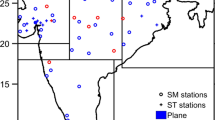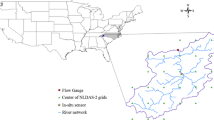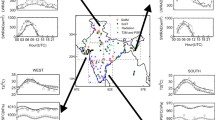Abstract
The ability of the Weather Research and Forecasting (WRF) model to simulate multilevel soil moisture (SM), 2-m air temperature (T2m), and 2-m relative humidity (RH2m) was evaluated for five different locations in India. WRF model simulations were carried out for 30 cases during different seasons with two different land surface schemes, viz. Noah and Rapid Update Cycle (RUC). The simulations were compared with in situ observations taken routinely at 30-min time intervals at the five selected locations. Statistical evaluation showed that, although the model could simulate SM reasonably well [with the majority of cases falling in the < 25% relative error (RE) category] at different depths for Delhi (DLH) and Gulbarga (GLB), the model errors were high (with most cases falling in the > 50% RE category) for Almora (ALR), Hyderabad (HYD), and Cochin (CHN). In case of T2m, model errors were high (RE > 15%) over hilly terrain, e.g., at ALR, while errors were relatively lower (RE < 10%) for plane areas such as HYD, GLB, DLH, and CHN. In general, the diurnal variation showed that the model underestimated (overestimated) afternoon temperatures during nonrainy (rainy) days. RH2m was also well simulated by the model at the locations HYD, GLB, and CHN, although it underestimated RH2m during morning hours at the locations ALR and DLH. Overall, the comparison showed that the WRF model could reproduce the near-surface temperature and humidity for plane areas such as HYD, GLB, and CHN reasonably well, but has limitations for complex terrains, e.g., at ALR, and highly polluted cities such as DLH.









Similar content being viewed by others
References
Attada, R., Kumar, P., & Dasari, H. R. (2018). Assessment of land surface models in a high-resolution atmospheric model during Indian summer monsoon. Pure and Applied Geophysics, 17, 1–26.
Banks, R. F., et al. (2016). Sensitivity of boundary-layer variables to PBL schemes in the WRF model based on surface meteorological observations, lidar, and radiosondes during the HygrA-CD campaign. Atmospheric Research, 176, 185–201.
Beljaars, A. C. M., et al. (1996). The anomalous rainfall over the United States during July 1993: Sensitivity to land surface parameterization and soil moisture anomalies. Monthly Weather Review, 124(3), 362–383.
Benjamin, S. G., et al. (2004). Mesoscale weather prediction with the RUC hybrid isentropic–terrain-following coordinate model. Monthly Weather Review, 132(2), 473–494.
Bhimala, K. R., & Goswami, P. (2015). A comparison of ASCAT soil moisture data with in situ observations over the Indian region: A multiscale analysis. IEEE Transactions on Geoscience and Remote Sensing, 53(10), 5425–5434.
Chang, H. I., et al. (2009). The role of land surface processes on the mesoscale simulation of the July 26, 2005 heavy rain event over Mumbai, India. Global and Planetary Change, 67(1–2), 87–103.
Chaurasia, S., Tung, D. T., Thapliyal, P. K., & Joshi, P. C. (2011). Assessment of the AMSR-E soil moisture product over India. International Journal of Remote Sensing, 32(23), 7955–7970.
Chawla, I., et al. (2018). Assessment of the weather research and forecasting (WRF) model for simulation of extreme rainfall events in the upper Ganga Basin. Hydrology and Earth System Sciences, 22(2), 1095.
Chen, F., & Dudhia, J. (2001). Coupling an advanced land surface–hydrology model with the Penn State–NCAR MM5 modeling system Part I: Model implementation and sensitivity. Monthly Weather Review, 129(4), 569–585.
Chen, F., et al. (1996). Modeling of land surface evaporation by four schemes and comparison with FIFE observations. Journal of Geophysical Research: Atmospheres, 101(D3), 7251–7268.
Chen, F., et al. (1997). Impact of atmospheric surface-layer parameterizations in the new land-surface scheme of the NCEP mesoscale Eta model. Boundary-Layer Meteorology, 85(3), 391–421.
Collow, T. W., Robock, A., & Wu, W. (2014). Influences of soil moisture and vegetation on convective precipitation forecasts over the United States Great Plains. Journal of Geophysical Research: Atmospheres, 119(15), 9338–9358.
Das, S., et al. (2008). Skills of different mesoscale models over Indian region during monsoon season: Forecast errors. Journal of Earth System Science, 117(5), 603–620.
Dash, S. K., Sahu, D. K., & Sahu, S. C. (2013). Impact of AWS observations in WRF-3DVAR data assimilation system: a case study on abnormal warming condition in Odisha. Natural Hazards, 65(1), 767–798.
Douville, H. (2010). Relative contribution of soil moisture and snow mass to seasonal climate predictability: A pilot study. Climate Dynamics, 34(6), 797–818.
Dumedah, G., Walker, J. P., & Merlin, O. (2015). Root-zone soil moisture estimation from assimilation of downscaled soil moisture and ocean salinity data. Advances in Water Resources, 84, 14–22.
Durre, I., Wallace, J. M., & Lettenmaier, D. P. (2000). Dependence of extreme daily maximum temperatures on antecedent soil moisture in the contiguous United States during summer. Journal of Climate, 13(14), 2641–2651.
Ek, M. B., et al. (2003). Implementation of Noah land surface model advances in the National Centers for Environmental Prediction operational mesoscale Eta model. Journal of Geophysical Research: Atmospheres, 108(D22).
Fennessy, M. J., & Shukla, J. (1999). Impact of initial soil wetness on seasonal atmospheric prediction. Journal of Climate, 12(11), 3167–3180.
Fischer, E. M., Seneviratne, S. I., Lüthi, D., & Schär, C. (2007). Contribution of land–atmosphere coupling to recent European summer heat waves. Geophysical Research Letters, 34(6).
Goswami, P., et al. (2012). Real-time quantitative rainfall forecasts at hobli-level over Karnataka: evaluation for the winter monsoon 2010. Current Science, 1426–1433.
Goswami, P., & Rakesh, V. (2016). An assessment of optimality of observations in high-resolution weather forecasting. Pure and Applied Geophysics, 173(4), 1359–1377.
Guo, Z., et al. (2006). GLACE: the global land–atmosphere coupling experiment. Part II: analysis. Journal of Hydrometeorology, 7(4), 611–625.
Haiyun, B., et al. (2016). Comparison of soil moisture in GLDAS model simulations and in situ observations over the Tibetan Plateau. Journal of Geophysical Research: Atmospheres, 121(6), 2658–2678.
Hanna, S. R., & Yang, R. (2001). Evaluations of mesoscale models’ simulations of near-surface winds, temperature gradients, and mixing depths. Journal of Applied Meteorology, 40(6), 1095–1104.
Kantharao, B., & Rakesh, V. (2018). Observational evidence for the relationship between spring soil moisture and June rainfall over the Indian region. Theoretical and Applied Climatology, 132(3–4), 835–849.
Kar, S. C., Mali, P., & Routray, A. (2014). Impact of land surface processes on the South Asian monsoon simulations using WRF modeling system. Pure and Applied Geophysics, 171(9), 2461–2484.
Koren, V., et al. (1999). A parameterization of snowpack and frozen ground intended for NCEP weather and climate models. Journal of Geophysical Research: Atmospheres, 104(D16), 19569–19585.
Koster, R. D., et al. (2003). Observational evidence that soil moisture variations affect precipitation. Geophysical Research Letters, 30(5).
Koster, R. D., et al. (2004). Regions of strong coupling between soil moisture and precipitation. Science, 305(5687), 1138–1140.
Koster, R. D., et al. (2006). GLACE: the global land–atmosphere coupling experiment. Part I: overview. Journal of Hydrometeorology, 7(4), 590–610.
Kumar, P., et al. (2011). Impact of additional surface observation network on short range weather forecast during summer monsoon 2008 over Indian subcontinent. Journal of Earth System Science, 120(1), 53–64.
Lee, C. B., et al. (2016). Performance evaluation of four different land surface models in WRF. Asian Journal of Atmospheric Environment, 10(1), 42–50.
Mahrt, L., & Ek, M. (1984). The influence of atmospheric stability on potential evaporation. Journal of Climate and Applied Meteorology, 23(2), 222–234.
Mahrt, L., & Pan, H. (1984). A two-layer model of soil hydrology. Boundary-Layer Meteorology, 29(1), 1–20.
Miao, J. F., et al. (2008). Evaluation of MM5 mesoscale model at local scale for air quality applications over the Swedish west coast: Influence of PBL and LSM parameterizations. Meteorology and Atmospheric Physics, 99(1–2), 77–103.
Moradkhani, H., Hsu, K. L., Gupta, H., & Sorooshian, S. (2005). Uncertainty assessment of hydrologic model states and parameters: Sequential data assimilation using the particle filter. Water Resources Research, 41(5).
Murphy, A. H. (1991). Forecast verification: Its complexity and dimensionality. Monthly Weather Review, 119, 1590–1601.
Murphy, A. H. (1993). What is a good forecast? An essay on the nature of goodness in weather forecasting. Weather and Forecasting, 8, 281–293.
Pal, J. S., & Eltahir, E. A. (2001). Pathways relating soil moisture conditions to future summer rainfall within a model of the land–atmosphere system. Journal of Climate, 14(6), 1227–1242.
Pal, P., Rakesh, V., Singh, R., & Joshi, P. C. (2007). Impact of satellite derived land surface parameters in regional climate simulations over India. Hydrology review (Jalvigyan Sameeksha), 22, 133–156.
Pan, H. L., & Mahrt, L. (1987). Interaction between soil hydrology and boundary-layer development. Boundary-Layer Meteorology, 38(1–2), 185–202.
Rakesh, V., and Goswami, P. (2011). Impact of background error statistics on forecasting of tropical cyclones over the north Indian Ocean. Journal of Geophysical Research: Atmospheres, 116(D20).
Rakesh, V., & Goswami, P. (2015). Impact of data assimilation on high-resolution rainfall forecasts: A spatial, seasonal and category analysis. Journal of Geophysical Research: Atmospheres, 120, 359–377. https://doi.org/10.1002/2014JD022383.
Rakesh, V., Goswami, P., & Prakash, V. S. (2016). Evaluation of high resolution rainfall forecasts over Karnataka for the 2011 southwest and northeast monsoon seasons. Meteorological Applications, 22(1), 37–47.
Ratnam, J. V., et al. (2017). Sensitivity of Indian summer monsoon simulation to physical parameterization schemes in the WRF model. Climate Research, 74(1), 43–66.
Schaake, J. C., et al. (1996). Simple water balance model for estimating runoff at different spatial and temporal scales. Journal of Geophysical Research: Atmospheres, 101(D3), 7461–7475.
Seneviratne, S. I., Lüthi, D., Litschi, M., & Schär, C. (2006). Land–atmosphere coupling and climate change in Europe. Nature, 443(7108), 205.
Skamarock, W.C., et al. (2008). A Description of the Advanced Research WRF Version 3, NCAR technical note, NCAR/TN-475 + STR.
Smirnova, T. G., Brown, J. M., & Benjamin, S. G. (1997). Performance of different soil model configurations in simulating ground surface temperature and surface fluxes. Monthly Weather Review, 125(8), 1870–1884.
Smirnova, T. G., et al. (2000). Parameterization of cold-season processes in the MAPS land-surface scheme. Journal of Geophysical Research: Atmospheres, 105(D3), 4077–4086.
Smirnova, T. G., et al. (2016). Modifications to the rapid update cycle land surface model (RUC LSM) available in the weather research and forecasting (WRF) model. Monthly Weather Review, 144(5), 1851–1865.
Song, Z., et al. (2012). Effects of surface tillage regimes on soil moisture and temperature of spring corn farmland in Northeast China. Transactions of the Chinese Society of Agricultural Engineering, 28(16), 108–114.
Srivastava, P. K., et al. (2015). Performance evaluation of WRF-Noah land surface model estimated soil moisture for hydrological application: Synergistic evaluation using SMOS retrieved soil moisture. Journal of Hydrology, 529, 200–212.
Tomasi, E. L., et al. (2017). Optimization of noah and noah_MP WRF land surface schemes in snow-melting conditions over complex terrain. Monthly Weather Review, 145, 4727–4745.
Unnikrishnan, C. K., et al. (2016). Impact of high resolution land surface initialization in Indian summer monsoon simulation using a regional climate model. Journal of Earth System Science, 125(4), 677–689.
Viterbo, P., & Betts, A. K. (1999). Impact on ECMWF forecasts of changes to the albedo of the boreal forests in the presence of snow. Journal of Geophysical Research: Atmospheres, 104(D22), 27803–27810.
Wilks, D. S. (2006). Statistical methods in the atmospheric sciences. International Geophysics Series (2nd ed., Vol. 91). San Diego: Academic.
Yang, J., et al. (2015). Enhancing hydrologic modelling in the coupled weather research and forecasting–urban modelling system. Boundary-Layer Meteorology, 155(1), 87–109.
Zeng, X. M., et al. (2015). WRF-simulated sensitivity to land surface schemes in short and medium ranges for a high-temperature event in East China: A comparative study. Journal of Advances in Modeling Earth Systems, 7(3), 1305–1325.
Zhang, D. L., & Zheng, W. Z. (2004). Diurnal cycles of surface winds and temperatures as simulated by five boundary layer parameterizations. Journal of Applied Meteorology, 43(1), 157–169.
Zhang, S., Lövdahl, L., Grip, H., Tong, Y., Yang, X., & Wang, Q. (2009). Effects of mulching and catch cropping on soil temperature, soil moisture and wheat yield on the Loess Plateau of China. Soil and Tillage Research, 102(1), 78–86.
Zhang, H., Pu, Z., & Zhang, X. (2013). Examination of errors in near-surface temperature and wind from WRF numerical simulations in regions of complex terrain. Weather and Forecasting, 28(3), 893–914.
Zu-Heng, H., et al. (2014). Evaluation of the WRF model with different land surface schemes: A drought event simulation in Southwest China during 2009–10. Atmospheric and Oceanic Science Letters, 7(2), 168–173.
Acknowledgements
The authors are grateful to the CSIR for making available the meteorological observation data. The authors acknowledge the National Center for Atmospheric Research (NCAR) for its support for the WRF modeling system (www.mmm.ucar.edu/wrf) and the National Centers for Environmental Prediction (NCEP) for making available the analysis data (http://ncep.noaa.gov/pub/data/nccf/com/gfs/prod). The CSIR 4PI high-performance computing (HPC) facility used for computing is gratefully acknowledged. The authors also acknowledge support and encouragement from the Head CSIR 4PI.
Author information
Authors and Affiliations
Corresponding author
Electronic supplementary material
Below is the link to the electronic supplementary material.
Rights and permissions
About this article
Cite this article
Kantha Rao, B., Rakesh, V. Evaluation of WRF-simulated multilevel soil moisture, 2-m air temperature, and 2-m relative humidity against in situ observations in India. Pure Appl. Geophys. 176, 1807–1826 (2019). https://doi.org/10.1007/s00024-018-2022-7
Received:
Revised:
Accepted:
Published:
Issue Date:
DOI: https://doi.org/10.1007/s00024-018-2022-7




